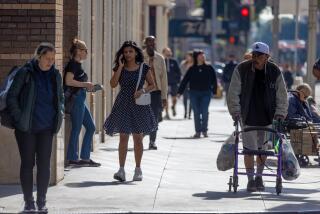Gridlock Stage Thought Near for Adoptions in L.A. County
With seven times as many children available for adoption as it can place, the county’s adoption agency is nearing gridlock, officials and adoptive parents report.
“We may be on the verge of crisis,” said Catherine Tracy, chief deputy of Children’s Services, who oversees adoptions in the largest such agency in the country.
In an effort to draw attention to the worsening situation, about 25 adoptive parents recently formed an Adoption Action Committee. The group last month wrote local and state officials detailing their concerns about interminable adoption delays, burdensome social worker caseloads and other complaints.
A San Dimas postal worker who has adopted several children, has taken in numerous foster children and is a member of the Action Committee noted that one effect of the overwhelming caseloads is that social workers who must juggle more than 100 cases simultaneously have had to resort to such measures as monthly “drive-by” curbside visits to stay in touch with their young charges.
‘Never Met the Man’
“I had a 14-year-old boy with me for six months,” said the man, who asked not to be identified. “The worker who brought him over quit, and I talked to the new one only on the phone. He’d call to say, ‘I’ll be by about 3:30. Could you have John come out front?’ I never met the man and he never saw the inside of my house. He’d just stop at the curb and John would lean against the car and they’d talk for five or 10 minutes.
“At least he was doing his best to comply with the law (which requires monthly home visits). I’ve had kids since who have never seen their social worker.”
Tracy said her workers will be doing well to place 500 of the estimated 3,600 children who will be available for adoption this year, down from the usual 600-700 placements of recent years. “And their time is running out,” she notes. “The longer we take to place them the harder it is.”
She said the adoptive parents have a point.
“I’m pretty much in agreement with their (the Adoption Action Committee) concerns,” she said, “although I’m not sure they--or Los Angeles County--understand how this came about.”
Among the factors that may have provoked the situation, she said, are recent legislation, too little money, too few adoption workers and outmoded methods of matching children aching for a family with would-be parents aching for a child.
More children are becoming available for adoption because of a recent state law that speeds up the process by which children who have been taken from their parents because of abuse or neglect must either be reunited with the family or freed for adoption, rather than left in limbo for years and shifted from foster home to foster home. So-called “permanency planning” for each must take place within 18 months.
But the Legislature apparently did not anticipate the impact of that law on adoptions.
“I get another 120 children every month like clockwork,” Tracy said. In recent months that number has climbed as high as 220.
In its letter last month, the Adoption Action Committee made note of several concerns:
- Prospective adoptive parents sometimes have to wait years to be screened and approved, and wait longer still for a child, even when they are applying for older children with special needs. Many finally just give up or adopt children from neighboring states.
1,000 Prospective Parents
According to county statistics, as of January nearly 1,000 prospective parents were waiting to be assigned to a social worker, 2,200 were undergoing home studies, and 700 were already approved and waiting for a child. More than 800 children were legally freed for adoption and awaiting placement, although homes for only about 50 or 60 were being actively sought, sources said. There were 144 adoption workers available to make the matches, although an additional 20 workers are being hired. No homes were being sought for 250 children deemed unadoptable.
- Adoption workers are handling up to 140 cases each, nearly three times the number their counterparts in nearby counties carry and are consequently unable to comply with visitation and supervision laws.
- The combination of relatively low pay, high stress and unreasonable workloads leads to burnout and turnover of social workers, whose cases are then divvied up among their colleagues, assigned to untrained new workers or left for months collecting dust on a supervisor’s desk.
- Social workers have little time to get pertinent information about adoptable children or suitable families, and there is no organized matching system. Frequently, a child in the system never sees the same worker twice.
The group’s letter described one 12-year-old girl in a group home saying goodby to her fifth social worker. She burst into tears, saying, “Why is it every time somebody says they will help me, they leave?”
- Adoption assistance payments are often months late.
- Adoptees who are entitled by law to information about their birth parents, if both sides sign a waiver of confidentiality, sometimes wait months or years just to get an appointment to sign the necessary papers or to receive information by mail.
“It’s never been this bad, ever. This is just about like gridlock,” said member Donna Salisbury, who runs a support service called Adoption Warmline and who adopted two children years ago. “You can’t scream at the cars--or in this case the social workers--in the middle and tell them to move. They can’t.”
Members of the Adoption Action Committee say their efforts have elicited little more than noncommittal responses that only underscore their contention that the bulk of attention and money are focused on protecting children coming into the system and little on those waiting to be adopted.
“It’s ludicrous for us to protect a child for two or three or four years and not be able to finish the job,” pointed out a high-ranking Children’s Services official who asked not to be identified.
‘Dickensian Situation’
Added Tracy: “It’s one thing to save a life. It’s another to make a plan so that a child becomes a productive member of society and not a warehoused orphan. . . . It’s a Dickensian situation. . . . We’re building up a reservoir of children--we go through legal action to free them (for adoption) and then have no adoptive homes for them.”
Both the Adoption Action Committee and support groups like HAPLA (Hispanic Adoptive Parents of Los Angeles) and BLAC (Black Linkage of Adoptive Children) point to the adoptions division’s inability to handle applications from prospective parents after putting on successful matching events, such as the Latino fiesta and black adoptions fair, at which available children and prospective parents can meet informally.
In reality, there is frequently no follow-up with families who have indicated an interest in a particular child. The applicant often attends the same event the next year, only to learn that the same child is still waiting for a home, just as they are still waiting for a child.
Different Kind of Child
Not only has the number of children referred for adoptions tripled during the last five years, but the kind of children available has changed, too.
Birth control, abortion and increasing numbers of babies adopted privately have caused the number of infants relinquished by their mothers here to dwindle to about 80 a year. The remainder are babies born to mothers on drugs, older children, kids who have been badly abused or neglected, groups of brothers and sisters, and youngsters with severe emotional or physical problems.
About 1,200-1,800 referrals, about half of those received, are classified as “good bets” for adoption, meaning that they have no good family ties and are under 13 years old. But homes for only about 500 will be found this year, Tracy estimates.
Funds Remain Static
State funds for the county’s adoptions program have stayed static for the last four years at about $7.2 million, although the county adoptions division overspent this figure by $1 million last year. An extra $1.2 million is expected from the state this year, but that money is supposed to cover increased expenses related to the cost of living, not money for new or expanded programs. Funding is pegged to the number of placements, which are decreasing.
Tracy said she will need $2.5 million more in adoptions money “to do something I’m not ashamed of.”
She pointed to some improvements, such as a new computer system that should help workers better match children with suitable adoptive parents, training sessions for new workers and a pilot program beginning in South-Central Los Angeles in which children who are “sure bets” for adoption--the baby left in a phone booth, for example--will be placed with families within two weeks rather than two years. The caretakers will be licensed as foster parents for 18 months and then move into the adoptions phase.
Already, half of adoptive placements are with former foster parents. Under a “fost-adopt” arrangement, children who are likely to eventually be freed for adoption are placed with foster parents who have expressed an interest in adopting.
Sources within the department said the adoptions division is to be merged with the rest of children’s services within the next two years.
Some Suggestions
But those involved in the adoptions system say much more could be done:
- Trans-racial adoptions should be considered more often. Placing a black child with a white family may not be the ideal match, but it may be preferable to leaving the child in foster care.
- Counseling and other services for both adoptees and their new families should be automatically provided, not just arranged upon request as they currently are under a federally funded adoptions assistance program.
- A photo-listing book, using only the child’s first name but including a photograph and basic information about him, should be made available to prospective parents in various Children’s Services offices. A would-be parent interested in a particular child could leave his resume in a box for the child’s worker.
- Clerical staff should be trained in word processing to speed up the endless paper work that seems to accompany all phases of the adoption process.
- Dependency Court hearings could be scheduled for specific times, rather than requiring social workers involved to show up at 8 a.m. and wait all day.
- Applicants who have been rejected should be told and given the reason, so that they don’t wait with false hopes.
More to Read
Start your day right
Sign up for Essential California for news, features and recommendations from the L.A. Times and beyond in your inbox six days a week.
You may occasionally receive promotional content from the Los Angeles Times.






